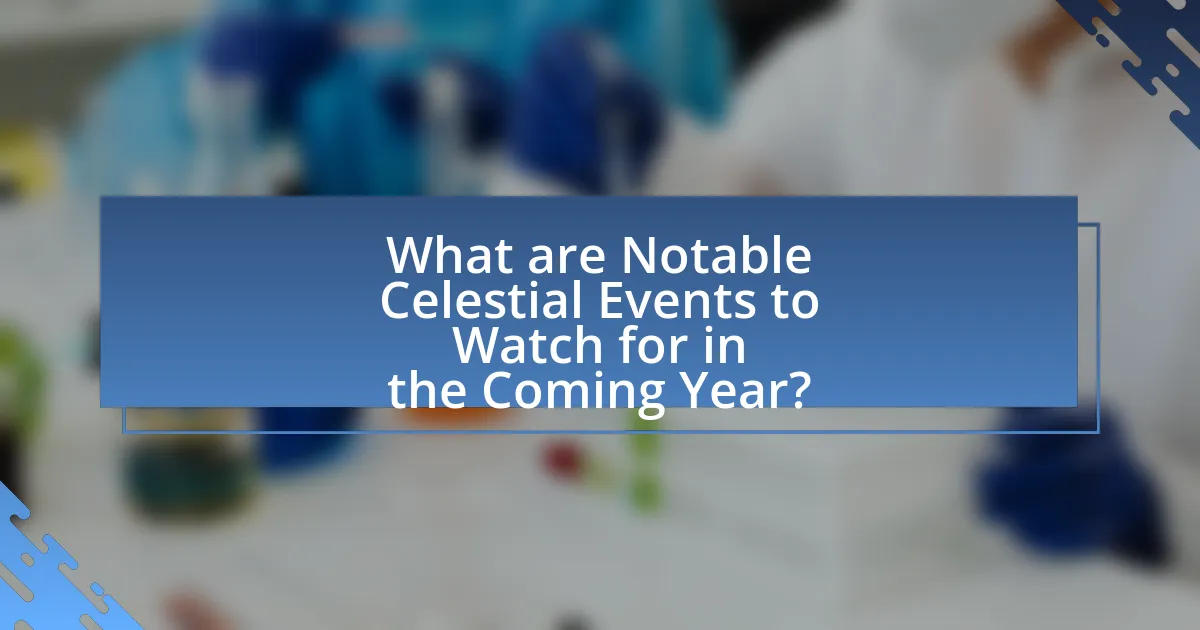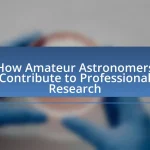The article focuses on notable celestial events to observe in the coming year, highlighting significant occurrences such as the total solar eclipse on April 8, 2024, and various meteor showers, including the Perseids and Geminids. It discusses the importance of these events for astronomy enthusiasts, detailing how they enhance understanding of the universe and provide opportunities for observation and education. The article also outlines the types of celestial events expected, their schedules, ideal viewing locations, and the impact of light pollution on visibility. Additionally, it offers practical tips for preparation, equipment recommendations, and resources for learning about these astronomical phenomena.

What are Notable Celestial Events to Watch for in the Coming Year?
Notable celestial events to watch for in the coming year include a total solar eclipse on April 8, 2024, which will be visible across parts of Mexico, the United States, and Canada. This event is significant as total solar eclipses occur approximately every 18 months, but the path of totality, where the sun is completely obscured, is limited to a narrow area. Additionally, there will be several meteor showers, including the Perseids in August and the Geminids in December, which are known for their high activity rates, with the Perseids producing up to 100 meteors per hour at their peak. These events provide excellent opportunities for observation and photography, making them noteworthy for astronomy enthusiasts and the general public alike.
Why are celestial events significant for astronomy enthusiasts?
Celestial events are significant for astronomy enthusiasts because they provide unique opportunities for observation, education, and engagement with the cosmos. These events, such as eclipses, meteor showers, and planetary alignments, allow enthusiasts to witness astronomical phenomena that can enhance their understanding of celestial mechanics and the universe. For instance, the total solar eclipse of 2017 drew millions of viewers across the United States, highlighting the public’s interest in such events and their ability to inspire curiosity about astronomy. Additionally, celestial events often serve as focal points for community gatherings, educational programs, and outreach efforts, fostering a shared passion for space exploration and scientific inquiry.
What types of celestial events can we expect this year?
This year, we can expect several notable celestial events, including meteor showers, lunar eclipses, solar eclipses, and planetary conjunctions. For instance, the Perseid meteor shower will peak around August 12, 2023, with an expected rate of up to 100 meteors per hour under optimal conditions. Additionally, a total lunar eclipse will occur on November 8, 2023, allowing observers to witness the moon turn a reddish hue. Furthermore, a solar eclipse will take place on October 14, 2023, where a ring of fire will be visible in certain regions. These events are based on astronomical predictions and historical patterns observed in previous years.
How do celestial events impact our understanding of the universe?
Celestial events significantly enhance our understanding of the universe by providing observable phenomena that can be studied to gain insights into cosmic processes. For instance, events like supernovae allow astronomers to investigate the life cycles of stars and the distribution of elements in the universe, while solar eclipses enable the study of the sun’s corona and its effects on space weather. Historical data from these events, such as the 1054 supernova observed by Chinese astronomers, has helped establish the expansion rate of the universe and the existence of neutron stars. Thus, celestial events serve as critical opportunities for empirical research, leading to advancements in astrophysics and cosmology.
When do these notable celestial events typically occur?
Notable celestial events typically occur throughout the year, with specific events scheduled at various times. For example, meteor showers like the Perseids peak around August 12, while the Geminids peak around December 14. Eclipses, such as solar and lunar eclipses, occur at least twice a year, with specific dates varying annually. The next total solar eclipse will occur on April 8, 2024. These occurrences are based on predictable astronomical cycles, making them reliable for observation.
What is the schedule for major celestial events in the coming year?
The schedule for major celestial events in the coming year includes several significant occurrences. Notable events are the total solar eclipse on April 8, 2024, which will be visible across parts of North America, and the Perseid meteor shower peaking on August 12-13, 2024, known for its bright meteors. Additionally, a penumbral lunar eclipse will occur on March 25, 2024, where the moon will pass through Earth’s outer shadow, creating a subtle shading effect. These events are based on astronomical predictions and historical data regarding celestial phenomena.
How can we track the timing of these events accurately?
To track the timing of notable celestial events accurately, utilize astronomical software and online resources that provide precise ephemeris data. These tools calculate the positions of celestial bodies and predict events like eclipses, meteor showers, and planetary alignments based on established astronomical algorithms. For instance, NASA’s Jet Propulsion Laboratory offers a reliable online tool called the “Solar System Dynamics Group,” which provides accurate timings for celestial events based on extensive observational data and mathematical models.
Where can we best observe these celestial events?
The best locations to observe notable celestial events include dark sky parks, remote areas away from city lights, and observatories. Dark sky parks, such as the Grand Canyon-Parashant National Monument in Arizona, provide optimal conditions due to minimal light pollution. Remote areas, like national forests or rural regions, also offer clear views of the night sky. Observatories, such as the Mauna Kea Observatories in Hawaii, are equipped with advanced telescopes and facilities for public viewing, enhancing the experience of celestial events. These locations are recognized for their ideal viewing conditions, making them suitable for observing phenomena like meteor showers, eclipses, and planetary alignments.
What locations are ideal for viewing specific celestial events?
Ideal locations for viewing specific celestial events include areas with minimal light pollution, high elevation, and clear skies. For example, the Atacama Desert in Chile is renowned for its dark skies, making it perfect for stargazing and observing events like meteor showers and eclipses. Similarly, Mauna Kea in Hawaii offers high altitude and clear atmospheric conditions, ideal for solar and lunar eclipses. National parks such as Big Bend in Texas and Jasper in Canada are also excellent choices due to their remote locations and efforts to reduce light pollution, enhancing visibility for events like the Perseid meteor shower and the annual Geminids.
How does light pollution affect our ability to see celestial events?
Light pollution significantly hinders our ability to see celestial events by obscuring the visibility of stars, planets, and other astronomical phenomena. This artificial brightness, primarily from urban areas, overwhelms the natural light emitted by celestial bodies, making it difficult for the human eye to detect faint objects in the night sky. Studies indicate that over 80% of the world’s population lives under light-polluted skies, which diminishes the visibility of events such as meteor showers, eclipses, and planetary alignments. For instance, the International Dark-Sky Association highlights that light pollution can reduce the visibility of stars by up to 90% in urban environments, severely impacting both amateur and professional astronomical observations.

What are the Major Types of Celestial Events to Anticipate?
The major types of celestial events to anticipate include solar eclipses, lunar eclipses, meteor showers, planetary conjunctions, and supermoons. Solar eclipses occur when the Moon passes between the Earth and the Sun, blocking sunlight, while lunar eclipses happen when the Earth casts a shadow on the Moon. Meteor showers are caused by Earth passing through debris left by comets, resulting in visible streaks of light in the sky. Planetary conjunctions occur when two or more planets appear close together in the sky, and supermoons happen when a full moon coincides with the Moon’s closest approach to Earth, making it appear larger and brighter. These events are predictable based on astronomical calculations and have been documented by organizations such as NASA.
What are the differences between solar and lunar eclipses?
Solar eclipses occur when the Moon passes between the Earth and the Sun, blocking sunlight either partially or completely, while lunar eclipses happen when the Earth passes between the Sun and the Moon, causing the Earth’s shadow to fall on the Moon. In a solar eclipse, the alignment results in the Sun being obscured from view, whereas in a lunar eclipse, the Moon takes on a reddish hue due to the Earth’s atmosphere filtering sunlight. Solar eclipses can only be seen from specific locations on Earth, while lunar eclipses are visible from anywhere on the night side of the Earth.
How often do solar eclipses occur compared to lunar eclipses?
Solar eclipses occur approximately 2 to 5 times a year, while lunar eclipses happen about 2 to 3 times annually. This frequency difference is due to the alignment of the Earth, Moon, and Sun. Solar eclipses require a precise alignment where the Moon passes directly between the Earth and the Sun, which is less common than the alignment needed for lunar eclipses, where the Earth casts a shadow on the Moon. Historical data shows that in a typical year, there are usually more lunar eclipses than solar eclipses, reinforcing this pattern.
What safety precautions should be taken during a solar eclipse?
To safely observe a solar eclipse, individuals must use proper eye protection, specifically eclipse glasses that meet the ISO 12312-2 international safety standard. Regular sunglasses do not provide adequate protection against the intense sunlight during an eclipse, which can cause serious eye damage or blindness. According to the American Astronomical Society, only certified eclipse glasses or solar viewers should be used to prevent harmful solar radiation from reaching the eyes. Additionally, viewers should avoid looking directly at the sun without proper protection, even during partial phases of the eclipse, as this can still result in retinal burns.
What are meteor showers and when can we expect them?
Meteor showers are celestial events where numerous meteors are observed to radiate from a specific point in the night sky, typically occurring when Earth passes through the debris left by comets or asteroids. These showers can be expected at specific times of the year, with notable annual events including the Perseids in August, the Geminids in December, and the Quadrantids in January. Each of these meteor showers has a peak activity period, during which the number of visible meteors can reach up to several dozen per hour under optimal viewing conditions.
How do meteor showers form and what causes their peaks?
Meteor showers form when Earth passes through the debris left by comets or asteroids, which enter the atmosphere and burn up, creating visible streaks of light. The peaks of meteor showers occur when Earth intersects the densest part of this debris trail, typically during specific times of the year when the orbit of the Earth aligns with the path of the comet or asteroid. For example, the Perseids peak in mid-August when Earth travels through the debris from Comet Swift-Tuttle, resulting in a higher frequency of meteors.
What are the best practices for viewing meteor showers?
The best practices for viewing meteor showers include finding a dark location away from city lights, ensuring a clear sky without clouds, and allowing your eyes to adjust to the darkness for at least 20 minutes. Dark locations enhance visibility, as light pollution significantly diminishes the number of meteors seen. Clear skies are essential since clouds obstruct the view of meteors. Eye adjustment is crucial because it increases sensitivity to faint meteors, which can be missed if the eyes are not accustomed to low light. According to the American Meteor Society, optimal viewing times are typically after midnight when the sky is darkest and the radiant point of the meteor shower is highest in the sky.
What are planetary alignments and why are they noteworthy?
Planetary alignments occur when planets in our solar system appear to line up in a straight line from the perspective of Earth. These events are noteworthy because they can create visually stunning displays in the night sky and have been historically significant in various cultures, often associated with astrological interpretations and predictions. For example, the alignment of planets can enhance visibility for astronomical observations and provide opportunities for scientific study of planetary atmospheres and gravitational interactions.
How can we predict when planetary alignments will happen?
Planetary alignments can be predicted using astronomical calculations based on the orbits of the planets around the Sun. Astronomers utilize mathematical models and software that simulate planetary positions over time, allowing them to determine when planets will appear in a straight line from a specific vantage point on Earth. For example, the positions of the planets are tracked using their orbital periods, which are well-documented; Mercury takes about 88 days, Venus about 225 days, and Earth about 365 days to complete their orbits. By calculating the relative positions of these planets at specific times, astronomers can accurately forecast alignments. Historical data and ephemerides, which are tables that provide the positions of celestial objects, further validate these predictions, ensuring their reliability.
What tools can enhance our viewing experience of planetary alignments?
Telescopes and binoculars are essential tools that can enhance the viewing experience of planetary alignments. Telescopes provide magnification and clarity, allowing observers to see details of planets such as rings and surface features. Binoculars offer a wider field of view, making it easier to locate and track multiple planets during alignments. Additionally, astronomy apps and star charts can help users identify the positions of planets in the night sky, improving the overall experience by providing real-time information and guidance.

How Can We Prepare for These Celestial Events?
To prepare for notable celestial events, individuals should first research the specific dates and types of events occurring, such as meteor showers, eclipses, or planetary alignments. This preparation includes checking local weather forecasts to ensure clear skies on the event dates, as visibility is crucial for optimal viewing. Additionally, gathering necessary equipment, such as telescopes or binoculars, enhances the experience, while also ensuring that one has a comfortable viewing location, preferably away from city lights to reduce light pollution. Historical data shows that events like the Perseid meteor shower can attract large crowds, emphasizing the importance of planning ahead for both viewing conditions and potential gatherings.
What equipment is recommended for observing celestial events?
A telescope is recommended for observing celestial events, as it provides detailed views of planets, stars, and other astronomical phenomena. Binoculars can also be useful for casual observation, offering a wider field of view and portability. Additionally, a star chart or astronomy app enhances the experience by helping observers identify celestial objects and events. These tools are essential for maximizing the enjoyment and understanding of notable celestial events, such as eclipses and meteor showers.
How do telescopes differ in their suitability for various events?
Telescopes differ in their suitability for various events primarily based on their design, aperture size, and optical capabilities. For instance, larger aperture telescopes, such as those with 8 inches or more, are better suited for observing faint celestial objects like distant galaxies during events like meteor showers or deep-sky observations. In contrast, smaller telescopes, typically with a 4-inch aperture, are more effective for viewing brighter objects such as the Moon or planets during events like conjunctions or transits. Additionally, telescopes with specialized filters can enhance visibility during solar or lunar eclipses, making them more suitable for those specific events. Thus, the choice of telescope directly impacts the quality and detail of observations during notable celestial events.
What are the benefits of using binoculars for celestial observation?
Using binoculars for celestial observation enhances the viewing experience by providing a wider field of view and greater detail compared to the naked eye. Binoculars allow observers to see celestial objects such as the Moon, planets, and star clusters more clearly, revealing features like craters on the Moon or the rings of Saturn. Additionally, binoculars are portable and user-friendly, making them accessible for casual stargazers and experienced astronomers alike. Studies show that binoculars can improve the visibility of faint objects, with some models offering magnification of up to 10x or more, which significantly increases the ability to observe distant celestial phenomena.
What resources are available for learning about celestial events?
Various resources are available for learning about celestial events, including websites, mobile applications, and educational institutions. Websites like NASA’s official site provide detailed information on upcoming celestial events, including eclipses and meteor showers, along with educational articles and videos. Mobile applications such as SkySafari and Star Walk offer real-time tracking of celestial events and interactive sky maps. Additionally, many universities and planetariums offer public lectures and workshops focused on astronomy, enhancing understanding of celestial phenomena.
How can apps and websites enhance our understanding of celestial events?
Apps and websites enhance our understanding of celestial events by providing real-time data, educational resources, and interactive tools. These platforms often feature live tracking of astronomical phenomena, such as meteor showers and eclipses, allowing users to observe and learn about these events as they occur. For instance, apps like SkySafari and websites like NASA’s Eyes on the Solar System offer detailed simulations and visualizations that explain the mechanics behind celestial occurrences. Additionally, educational content, including articles and videos, helps users grasp complex concepts related to astronomy, making the information accessible to a broader audience.
What role do local astronomy clubs play in event observation?
Local astronomy clubs play a crucial role in event observation by organizing viewing events, providing access to telescopes, and facilitating educational opportunities for members and the public. These clubs often host star parties, where enthusiasts gather to observe celestial events such as meteor showers, eclipses, and planetary alignments, enhancing the experience through shared knowledge and equipment. According to a survey conducted by the American Astronomical Society, over 70% of club members reported increased engagement in astronomy due to club activities, demonstrating the significant impact these organizations have on fostering interest and participation in astronomical events.
What tips can help maximize the experience of watching celestial events?
To maximize the experience of watching celestial events, choose a location with minimal light pollution, such as national parks or rural areas. Light pollution significantly affects visibility; for instance, urban areas can reduce the visibility of celestial objects by up to 90%. Additionally, check the weather forecast to ensure clear skies, as clouds can obstruct views of celestial phenomena. Using binoculars or a telescope can enhance the experience by providing a closer look at planets and other celestial bodies. Engaging with local astronomy clubs or attending organized viewing events can also enrich the experience through shared knowledge and resources.
How should one plan for weather conditions during celestial events?
To plan for weather conditions during celestial events, one should monitor weather forecasts leading up to the event and have contingency plans in place. Accurate weather predictions can be obtained from reliable meteorological sources, which provide updates on cloud cover, precipitation, and visibility. For instance, the National Weather Service offers detailed forecasts that can help determine the best viewing conditions. Additionally, having alternative viewing locations or dates can ensure that one does not miss the event due to unfavorable weather.
What are the best practices for photographing celestial events?
The best practices for photographing celestial events include using a sturdy tripod, selecting the right camera settings, and planning the shoot in advance. A sturdy tripod stabilizes the camera during long exposures, which are often necessary for capturing faint celestial objects. Optimal camera settings typically involve using a low ISO to reduce noise, a wide aperture to allow more light, and a longer shutter speed to capture details. Additionally, planning involves checking weather conditions, knowing the event’s timing, and scouting locations with minimal light pollution to enhance image quality. These practices are supported by the fact that many astrophotographers achieve better results by adhering to these guidelines, as evidenced by numerous tutorials and expert recommendations in the field.


